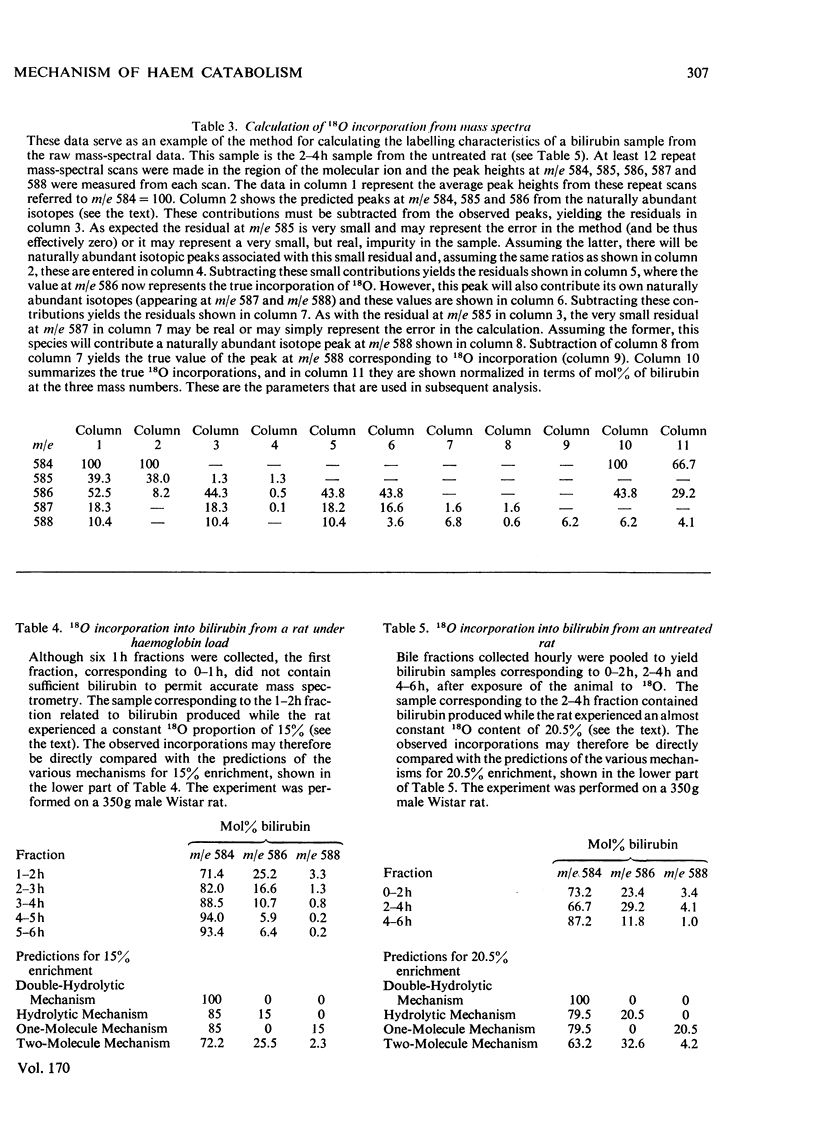Abstract
1. The pathway of haem breakdown in living rats was studied by using 18O in the oxygen that the animals consumed. By cannulation of the common bile duct and collection of bile, labelled bilirubin was isolated and its mass spectrum determined. One set of results was obtained for a rat to which haemoglobin had been intravenously administered and another set obtained for a rat that was not given exogenous haem. Isomerization of bilirubin IXalpha to the XIIIalpha and IIIalpha isomers did not occur to any significant extent. The 18O-labelling pattern obtained in the bilirubin was consistent with a Two-Molecule Mechanism, whereby the terminal lactam oxygen atoms of bilirubin are derived from different oxygen molecules. The consequences of this mechanism are discussed in terms of the possible intermediates of the catabolic pathway. 2. 18O-labelled bilirubin appeared in the bile in less than 10 min after exposure of the animals to labelled oxygen. This result suggests that all of the chemical transformations involving production of biliverdin, reduction to bilirubin and conjugation of the bilirubin are fast processes. 3. The quantitative recovery of label obtained in the experiments suggests that there is little or no exchange of newly synthesized bilirubin with existing bilirubin pools in the animal.
Full text
PDF














Selected References
These references are in PubMed. This may not be the complete list of references from this article.
- Brown S. B., King R. F. An 18O double-labelling study of haemoglobin catabolism in the rat. Biochem J. 1975 Sep;150(3):565–567. doi: 10.1042/bj1500565. [DOI] [PMC free article] [PubMed] [Google Scholar]
- Brown S. B. Stereospecific haem cleavage. A model for the formation of bile-pigment isomers in vivo and in vitro. Biochem J. 1976 Oct 1;159(1):23–27. doi: 10.1042/bj1590023. [DOI] [PMC free article] [PubMed] [Google Scholar]
- EBAUGH F. G., Jr, EMERSON C. P., ROSS J. F. The use of radioactive chromium 51 as an erythrocyte tagging agent for the determination or red cell survival in vivo. J Clin Invest. 1953 Dec;32(12):1260–1276. doi: 10.1172/JCI102855. [DOI] [PMC free article] [PubMed] [Google Scholar]
- GRAY C. H., NEUBERGER A., SNEATH P. H. A. Studies in congenital porphyria. 2. Incorporation of 15N in the stercobilin in the normal and in the porphyric. Biochem J. 1950 Jun-Jul;47(1):87–92. doi: 10.1042/bj0470087. [DOI] [PMC free article] [PubMed] [Google Scholar]
- Jackson A. H., Kenner G. W. Recent developments in porphyrin chemistry. Biochem Soc Symp. 1968;28:3–18. [PubMed] [Google Scholar]
- Kirshenbaum G., Shames D. M., Schmid R. An expanded model of bilirubin kinetics: effect of feeding, fasting, and phenobarbital in Gilbert's syndrome. J Pharmacokinet Biopharm. 1976 Apr;4(2):115–155. doi: 10.1007/BF01086150. [DOI] [PubMed] [Google Scholar]
- Lathe G. H. The degradation of haem by mammals and its excretion as conjugated bilirubin. Essays Biochem. 1972;8:107–148. [PubMed] [Google Scholar]
- McDonagh A. F., Assisi F. Commercial bilirubin: A trinity of isomers. FEBS Lett. 1971 Nov 1;18(2):315–317. doi: 10.1016/0014-5793(71)80475-1. [DOI] [PubMed] [Google Scholar]
- McDonagh A. F., Assisi F. The ready isomerization of bilirubin IX- in aqueous solution. Biochem J. 1972 Sep;129(3):797–800. doi: 10.1042/bj1290797. [DOI] [PMC free article] [PubMed] [Google Scholar]
- OSTROW J. D., HAMMAKER L., SCHMID R. The preparation of crystalline bilirubin-C14. J Clin Invest. 1961 Aug;40:1442–1452. doi: 10.1172/JCI104375. [DOI] [PMC free article] [PubMed] [Google Scholar]
- OSTROW J. D., JANDL J. H., SCHMID R. The formation of bilirubin from hemoglobin in vivo. J Clin Invest. 1962 Aug;41:1628–1637. doi: 10.1172/JCI104620. [DOI] [PMC free article] [PubMed] [Google Scholar]
- Robinson S. H. The origins of bilirubin. N Engl J Med. 1968 Jul 18;279(3):143–149. doi: 10.1056/NEJM196807182790306. [DOI] [PubMed] [Google Scholar]
- SNYDER A. L., SCHMID R. THE CONVERSION OF HEMATIN TO BILE PIGMENT IN THE RAT. J Lab Clin Med. 1965 May;65:817–824. [PubMed] [Google Scholar]
- Schacter B. A., Nelson E. B., Marver H. S., Masters B. S. Immunochemical evidence for an association of heme oxygenase with the microsomal electron transport system. J Biol Chem. 1972 Jun 10;247(11):3601–3607. [PubMed] [Google Scholar]
- Schmid R., Marver H. S., Hammaker L. Enhanced formation of rapidly labelled bilirubin by phenobarbital: hepatic microsomal cytochromes as a possible source. Biochem Biophys Res Commun. 1966 Aug 12;24(3):319–328. doi: 10.1016/0006-291x(66)90158-6. [DOI] [PubMed] [Google Scholar]
- Schmid R., McDonagh A. F. The enzymatic formation of bilirubin. Ann N Y Acad Sci. 1975 Apr 15;244:533–552. doi: 10.1111/j.1749-6632.1975.tb41553.x. [DOI] [PubMed] [Google Scholar]
- TALAFANT E. Properties and composition of the bile pigment giving a direct diazo reaction. Nature. 1956 Aug 11;178(4528):312–312. doi: 10.1038/178312a0. [DOI] [PubMed] [Google Scholar]
- Tenhunen R., Marver H. S., Schmid R. Microsomal heme oxygenase. Characterization of the enzyme. J Biol Chem. 1969 Dec 10;244(23):6388–6394. [PubMed] [Google Scholar]
- Tenhunen R., Marver H. S., Schmid R. The enzymatic conversion of heme to bilirubin by microsomal heme oxygenase. Proc Natl Acad Sci U S A. 1968 Oct;61(2):748–755. doi: 10.1073/pnas.61.2.748. [DOI] [PMC free article] [PubMed] [Google Scholar]
- Tenhunen R., Marver H., Pimstone N. R., Trager W. F., Cooper D. Y., Schmid R. Enzymatic degradation of heme. Oxygenative cleavage requiring cytochrome P-450. Biochemistry. 1972 Apr 25;11(9):1716–1720. doi: 10.1021/bi00759a029. [DOI] [PubMed] [Google Scholar]
- Yoshida T., Takahashi S., Kikuchi G. Partial purification and reconstitution of the heme oxygenase system from pig spleen microsomes. J Biochem. 1974 May;75(5):1187–1191. doi: 10.1093/oxfordjournals.jbchem.a130494. [DOI] [PubMed] [Google Scholar]


